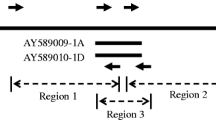Abstract
An intact cDNA fromArabidopsis thaliana for adenine phosphoribosyltransferase (APRT) was isolated and sequenced. The cDNA is 729 nucleotides in length and predicts a protein ofM r 27140. The deduced amino acid sequence has been compared with those of other APRTs and shown to be most similar to theEscherichia coli protein. Construction of a molecular tree of the known APRT amino acid sequences indicates theA. thaliana andE. coli APRT sequences form one cluster and the currently available vertebrate and invertebrate sequences form a separate grouping. Since it is possible to select either for or against the expression of APRT, the isolation of this APRT cDNA clone will allow these selection schemes to be used in plant genetic experiments.
Similar content being viewed by others
References
Arnold WJ, Kelley WN: Adenine phosphoribosyltransferase. Meth Enzymol 51: 568–574 (1978).
Broderick TP, Schaff DA, Bertino AM, Dush MK, Tischfield JA, Stambrook PJ: Comparative anatomy of the human APRT gene and enzyme: Nucleotide sequence divergence and conservation of a nonrandom CpG dinucleotide arrangement. Proc Natl Acad Sci USA 84: 3349–3353 (1987).
Dayhoff MO, Schwartz RM, Orcutt BC: A model of evolutionary change in proteins. In: Atlas of Protein Sequence and Structure, vol 5, suppl. 3 National Biomedical Research Foundation/M. O. Dayhoff, Washington, DC (1978).
Doolittle RF, Feng D-F: Nearest neighbor procedure for relating progressively aligned amino acid sequences. Meth Enzymol 183: 659–669 (1990).
Dush MK, Sikela JM, Khan SA, Tischfield JA, Stambrook PJ: Nucleotide sequence and organization of the mouse adenine phosphoribosyltransferase gene: Presence of a coding region common to animal and bacterial phosphoribosyltransferases that has a variable intron/exon arrangement. Proc Natl Acad Sci USA 82: 2731–2735 (1985).
Federoff N, Mauvais J, Chaleff D: Molecular studies on mutations at theShrunken locus in maize caused by the controlling elementDs. J Mol Appl Genet 2: 11–30 (1983).
Feinberg AP, Vogelstein B: A technique for radiolabelling DNA restriction endonuclease fragments to high specific activity. Anal Biochem 137: 266–267 (1984).
Feng D-F, Doolittle RF: Progressive alignment and phylogenetic tree construction of protein sequences. Meth Enzymol 183: 375–387 (1990).
Haughn GW, Somerville CR: Sulfonylurea-resistant mutants ofArabidopsis thaliana. Mol Gen Genet 204: 430–434 (1986).
Heidecker G, Messing J: Structural analysis of plant genes. Annu Rev Plant Physiol 37: 439–466 (1986).
Hein J: Unified approach to alignment and phylogenies. Meth Enzymol 183: 626–644 (1990).
Hershey HV, Gutstein R, Taylor MW: Cloning and restriction map of theE. coli apt gene. Gene 19: 89–92 (1982).
Hershey HV, Taylor MW: Nucleotide sequence and deduced amino acid sequence ofEscherichia coli adenine phosphoribosyltransferase and comparison with other analogous enzymes. Gene 43: 287–293 (1986).
Hidaka Y, Tarlé SA, O'Toole TE, Kelley WN, Palella TD: Nucleotide sequence of the human APRT gene. Nucl Acids Res 15: 9086 (1987).
Hochstadt-Ozer J, Stadtman ER: The regulation of purine utilization in bacteria. I. Purification of adenine phosphoribosyltransferase fromEscherichica coli K12 and control of activity by nucleotides. J Biol Chem 246: 5294–5303 (1971).
Hunt AG, Chu NM, Odell JT, Nagy F, Chua N-H: Plant cells do not properly recognize animal gene polyadenylation signals. Plant Mol Biol 8: 23–35 (1987).
Johnson DH, Edstrom J-E, Burnett JB, Friedman TB: Cloning of aDrosophila melanogaster adenine phosphoribosyltransferase structural gene and deduced amino acid sequence of the enzyme. Gene 59: 77–86 (1987).
Kusano T, Long C, Green H: A new reduced human-mouse somatic cell hybrid containing the human gene for adenine phosphoribosyltransferase. Proc Natl Acad Sci USA 68: 82–86 (1971).
Lahners K, Kramer V, Back E, Privalle L, Rothstein SJ: Molecular cloning of complementary DNA encoding maize nitrate reductase. Plant Physiol 88: 741–746 (1988).
Leutwiler LS, Hough-Evans BR, Meyerowitz EM: The DNA ofArabidopsis thaliana. Mol Gen Genet 194: 15–23 (1984).
Maniatis T, Fritsch EF, Sambrook J: Molecular Cloning: A Laboratory Manual. Cold Spring Harbor Laboratory, Cold Spring Harbor, NY (1982).
Moffatt BA, Pethe C, Laloue M: Metabolism of benzyladenine is impaired in a mutant ofArabidopsis thaliana lacking adenine phosphoribosyltransferase activity. Plant Physiol 95: 900–908 (1991).
Moffatt BA, Somerville CR: Positive selection for malesterile mutants ofArabidopsis thaliana lacking adenine phosphoribosyltransferase activity. Plant Physiol 86: 1150–1154 (1988).
Moffatt BA, Somerville CR: Purification of adenine phosphoribosyltransferase fromBrassica juncea. Arch Biochem Biophys 283: 484–490 (1990).
Nalbantoglu J, Phear GA, Meuth M: Nucleotide sequence of hamster adenine phosphoribosyltransferase (aprt) gene. Nucl Acids Res 14: 1914 (1986).
Okada G, Kaneko I, Koyama H: Purification and characterization of adenine phosphoribosyltransferase from mouse mammary carcinoma FM3A cells in culture. Biochim Biophys Acta 884: 304–310 (1986).
Pearson WR, Lipman DJ: Improved tools for biological sequence comparison. Proc Natl Acad Sci USA 85: 2444–2448 (1988).
Saitou N, Nei M: The nieghbor-joining method: a new method for reconstructing phylogenetic trees. Mol Biol Evol 4: 406–425 (1987).
Sikela JM, Khan SA, Feliciano E, Trill J, Tischfield JA, Stambrook PJ: Cloning and expression of a mouse adenine phosphoribosyltransferase gene. Gene 22: 219–228 (1983).
Stambrook PJ, Dush MK, Trill JJ, Tischfield JA: Cloning of a functional human adenine phosphoribosyltransferase (APRT) gene: Identification of a restriction fragment length polymorphism and preliminary analysis of DNAs from APRT-deficient families and cell mutants. Somatic Cell Mol Genet 10: 359–367 (1984).
Takayama KM, Inouye M: Antisense RNA. Crit Rev Biochem Biol 25: 155–184 (1990).
Tischfield JA, Ruddle FH: Assignment of the gene for adenine phosphoribosyltransferase to human chromosome 16 by mouse-human somatic cell hybridization. Proc Natl Acad Sci USA 71: 45–49 (1974).
Wilson JM, O'Toole TE, Argos P, Shewach DS, Daddona PE, Kelley WN: Human adenine phosphoribosyltransferase. Complete amino acid sequence of the erythrocyte enzyme. J Biol Chem 261: 13677–13683 (1986).
Author information
Authors and Affiliations
Rights and permissions
About this article
Cite this article
Moffatt, B.A., McWhinnie, E.A., Burkhart, W.E. et al. A complete cDNA for adenine phosphoribosyltransferase fromArabidopsis thaliana . Plant Mol Biol 18, 653–662 (1992). https://doi.org/10.1007/BF00020008
Received:
Accepted:
Issue Date:
DOI: https://doi.org/10.1007/BF00020008




